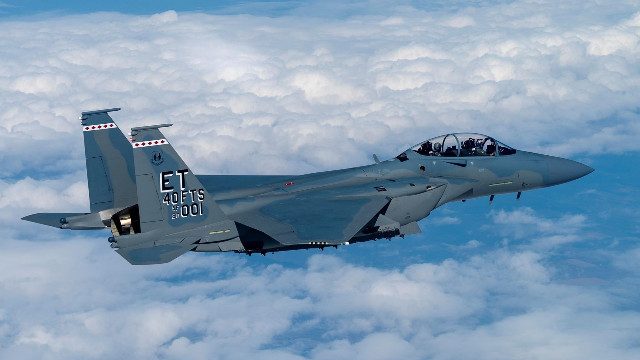
The United States Air Force’s 53rd Wing recently marked a significant milestone, as recorded by Air & Space Forces Magazine on August 30.

The F-15EX Eagle II, a new addition to the Air Force’s fleet, successfully executed a test flight loaded with a trio of Joint Air to Surface Standoff Missiles [JASSM] over Eglin Air Force Base, Florida.
Notably, the F-15EX Eagle II also showcased its remarkable air-to-air capabilities, deploying 12 Advanced Medium-Range Air-to-Air Missiles [AMRAAM] during the aforementioned flight.
A direct descendant of the proud F-15 Eagle family, the F-15EX Eagle II represents the pinnacle of this storied lineage of jet fighters. Born originally as the F-15, a divine chariot characterized by its air superiority back in 1972, it soon evolved into the F-15E Strike Eagle, a multi-role version that first graced the heavens in 1986. The freshest variant amongst the nest, the mighty F-15EX, was introduced into this grand family as recently as 2021.
The F-15EX Eagle II may mirror its predecessors superficially, but internally, it transcends its predecessors on an innovative thrust. This state-of-the-art aircraft boasts digital fly-by-wire flight controls, user-friendly interactive cockpit touchscreens and the fastest mission computer ever integrated into a fighter jet.

It further enhances survivability with the Eagle Passive/Active Warning system for effective defense against hostile air-to-air encounters. Further, it proudly showcases the Joint Helmet-Mounted Cueing System, the first of its kind. The innovative Open Mission System further complements, offering ease when applying software and hardware upgrades.
The F-15EX’s new computer, known as the Advanced Display Core Processor II [ADCP II], is a highly advanced and powerful system designed specifically for the F-15EX fighter jet. It is referred to as the fastest mission computer ever integrated into a fighter jet due to its exceptional specifications and capabilities.
The ADCP II features a quad-core Intel i7 processor, which provides a significant boost in processing power compared to previous generations of mission computers. With a staggering 87 billion instructions per second of processing power, this system is leagues ahead of the previous generation’s computer.
In addition to its powerful processor, the ADCP II also boasts an impressive amount of memory. It is equipped with 16 gigabytes of RAM, which allows for the storage and retrieval of large amounts of data in real time.

The F-15EX’s new computer also features advanced graphics capabilities. It is equipped with a high-performance graphics processing unit (GPU) that can handle complex visualizations and renderings. Furthermore, the ADCP II incorporates advanced networking capabilities, allowing for seamless communication and data sharing between the F-15EX and other aircraft or ground-based systems.
Overall, the specifications of the F-15EX’s new computer, the ADCP II, make it a cutting-edge system that significantly enhances the aircraft’s mission capabilities. Its powerful processor, ample memory, advanced graphics capabilities, and networking features contribute to its reputation as the fastest mission computer ever integrated into a fighter jet.
Despite mirroring the dimensions of its predecessors, the F-15EX emerged as a significantly more potent weapon carrier compared to the F-15A, F-15C, and F-15E, which were confined to possessing eight air-to-air missiles, commonly composed of AIM-9 Sidewinder infrared-guided missiles and AIM-7 Sparrow or AIM-120 AMRAAM radar-guided missiles.
The substantial increase in the F-15EX’s payload can be traced back to the incorporation of the Advanced Missile and Bomb Ejector Rack (AMBER) missile racks, which are innovative conveyor-like structures that facilitate connectivity between the aircraft and the ammunition. With these new racks, the F-15EX can accommodate up to 12 air-to-air missiles, a 50 percent improvement compared to its forerunners. AMBER’s influence extends to grant the F-15EX a total of 23 weapon stations, a noticeable upgrade from the 17 on the F-15E.

In regards to sheer capabilities, the variation of the F-15EX that participated in the Eglin tests seems to be the most heavily armed fighter jet in history. It offers the potential to disable no less than six enemy fighters, even if we assume a minimum kill probability of 50 percent per AMRAAM missile.
The triad of JASSM cruise missiles, with a reach of 250 miles and stealth contours to remain out of enemy radars, make it possible for the F-15EX to strike three heavily defended targets with remarkable accuracy and reliability.
Though other aircraft like the older F-15E Strike Eagle and the F/A-18E/F Super Hornet can carry more bombs or more explosives by weight, the F-15EX stands out for its symmetrical fighting load – making it capable of releasing its JASSM missiles at enemy defenses followed by immediate engagement in a different mission, such as targeting enemy aircraft.
The underlying reason that the F-15EX can maintain an unprecedented load, while aircraft like the F-35 Lightning II cannot, lies in the operational restrictions of stealth fighters.
Stealth aircraft must confine all their weapons internally to maintain their anti-radar design – hanging bombs, missiles, targeting pods, and fuel tanks off the wings and body of an F-35 would increase its detection by enemy radars, given the limited space within its internal weapons bays.
As the F-15EX does not adopt a stealth design, it enjoys the freedom to carry any weaponry desired, although this advantage comes with the understanding that a more heavily loaded aircraft will result in decreased speed and maneuverability.
The F-15EX Eagle II professed as a so-called “missile truck” for the less ammunition-intense F-35, can project AMRAAM air-to-air missiles toward targets that a concealed stealth fighter can detect. As an alternative proposition, this significant aircraft can deploy air-to-ground armaments against targets identified by an F-35, subtly monitoring from a superior position above the battleground.
The concept of a ‘missile truck’ may not initially resonate with the spectacle and allure of a stealth fighter. However, in a future combat scenario where the Air Force is obligated to withstand a significantly outnumbered situation, positioned thousands of miles away from its home base, this modest-sounding proposition could prove to be pivotal to victorious outcomes.